|
|
|
|
|
|
|
Achi-Kochi Japan
Showing many places to visit and foods to eat in Japan
|
|
|
|
|
|
|
|
|
|
|
|
|
Japan
> Shikoku region
> Uwajima City
|
|
|
|
|
|
|
Uwajima City
Ehime Pref., Shikoku ( Achi-Kochi Japan )
|
|
|
|
|
|
|
|
|
|
|
|
|
( "Achi-Kochi" in Japanese means "Here and there" in English. )
Uwajima City

Uwajima City, where almost 70 thousands people live, is located in the southwest of Ehime Prefecture. Uwajima is famous for Ushi-oni Matsuri ( festival ) and Togyu ( bull sumo fighting ). Uwajima-jo Castle is one of twelve castles whose main keeps remain extant. Two of the 88 temples consisting Shikoku Henro Pilgrimage are located in the city.
While Uwajima is famous for cultivatiion of pearls, Its fishing industry is thriving. So tourists could enjoy eating seafoods in the city where various kinds of local specialty dishes such as Tai-meshi are served in many restaurants and izakaya. Also Jakoten is famous as one of its local specialty foods.
|
|
Uwajima-jo Castle
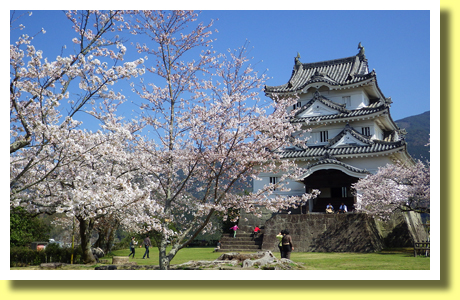
Uwajima-jo Castle ( above ), located on a mountain ( altitude 74m ) is one of the most popular tourist attractions in Uwajima City. In particular, lots of people, not only tourists but also local people, enjoy Sakura Viewing ( cherry blossom viewing ) on the site of the castle in the season of Hanami ( end of March - beginning of April ).
It is said that a fort was built in the 10th century on the mountain, where Marugushi-jo Castle was constructed in the 16th century. In A.D.1595, Takatora Todo became a feudal lord ruling Uwajima and he built Uwajima-jo Castle here.
In A.D.1614, Hidemune Date became a feudal lord of Uwajima Domain and he started the reconstruction of the castle. In A.D.1666, his son, Munetoshi Date completed the construction of the main keep, which remains extant and is one of designated National Important Cultural Properties of Japan.
|
|
Top Floor of Main Keep
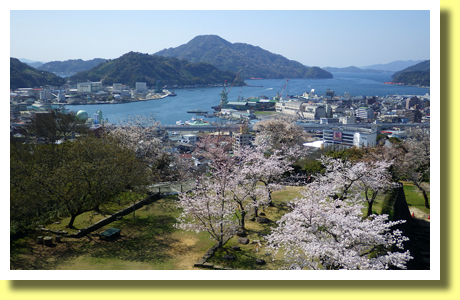
Tourists could walk up to the top floor of the main keep, where they could enjoy the view ( above ), overlooking the sea, the port, mountains and the city, which had developed as a castle town since Uwajima-jo Castle was built in the end of the 16th century.
|
|
Stone Walls of the castle

Most of the buildings of Uwajima-jo Castle had been pulled down after Meiji Period started except a few including the main keep. However stone walls ( above ) have been and are surviving on the site of the castle. Tourists could see the stone walls while walking up to and down from the main keep.
|
|
Warei-jinja Shrine
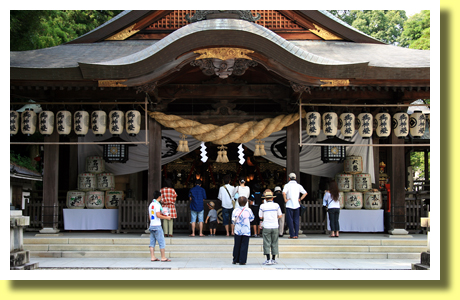
Warei-jinja Shrine ( above ), the most famous shrine in Uwajima, was founded in A.D.1653 by Hidemune Date, the first feudal lord of the Date Clan ruling Uwajima Domain to enshrine Kinyori Yanbe, who used to be one of important vassals of Hidemune Date.
However Kinyori Yanbe was murdered in A.D.1620 under the order of Hidemune who had believed an utter slander. However it turned out that Kinyori Yanbe was innocent. So Hidemune Date founded "Warei"-jinja. "Warei" here means "to console the spirit".
The shrine was relocated to its present site in A.D.1735. During W.W.II its structures were burnt down in air raids, which destroyed lots of buildings in Uwajima City. The buildings of the shrine were reconstructed in A.D.1957.
|
|
Ushi-oni ( bull demons ) Parade

Warei-jinja Shrine holds Ushi-oni Matsuri ( festival ) through 22nd July to 24th July every year. The most popular attraction in the festival is Ushi-oni Parade in which more than a dozen of Ushi-oni ( above ) participate.
"Ushi" in Japanese means bull or ox while "oni" means demon. So "Ushi-oni" means "bull demons". They have bull-like bodies and demon-like heads. However they are not evil. While coming down the street, they shake their heads up and down in front of houses not to destroy but to drive evil spirits away.
|
|
Ushi-oni revolving
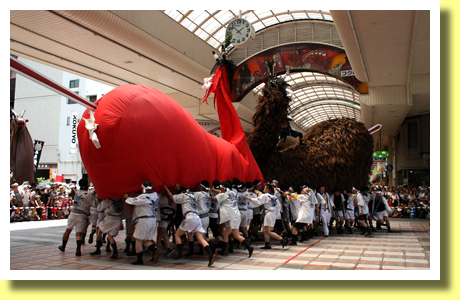
Sometimes on their parading, two or three of Ushi-oni face each other and revolve around vigorously ( above ) as if dancing, which please the lots of spectators.
|
|
Ushi-oni paying a courtesy
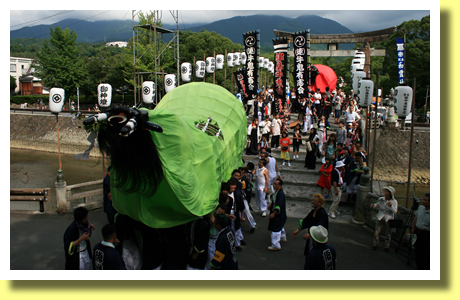
Ushi-oni cross a bridge ( above ) over the Suka River to pay courtesies to Warei-jinja Shrine, which holds Uwajima Ushi-oni Matsuri. Then they return.
During three days of Ushi-oni Matsuri, people enjoy not only Ushi-oni Parade but also some more attractions including fireworks, dancing and Togyu ( bull sumo fighting - see below ).
|
|
Tensha-en Garden
In A.D.1672, Munetoshi Date, the 2nd feudal lord of the Date Clan, built a palace near Uwajima-jo Castle. On the site of the palace, Tensha-en Garden ( above ) was constructed in A.D.1672 by Munetada Date, the 7th lord of the Date Clan.
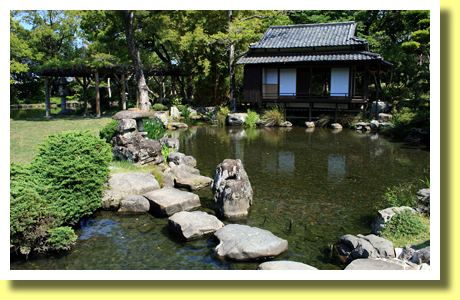
There in the garden is a pond, on the shore of which Harusame-tei ( above ) was built. Harusame-tei was a house for Munetada Date, a good calligrapher, to enjoy Japanese calligraphy. Tensha-en Garden is one of designated National Sutes of Scenic Beauty.
|
|
Togyu ( bull sumo fighting )
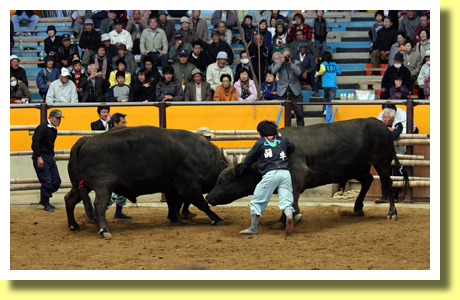
Uwajima is famous for Togyu ( bull sumo fighting - above ). In spain, a bull fights against a matador and a bull is frequently killed. On the contrary, two bulls fight in Uwajima and no bull is killed there. There in Uwajima is an arena specialized in Togyu, where Togyu tournaments are held five times a year.
|
|
Butsumoku-ji Temple
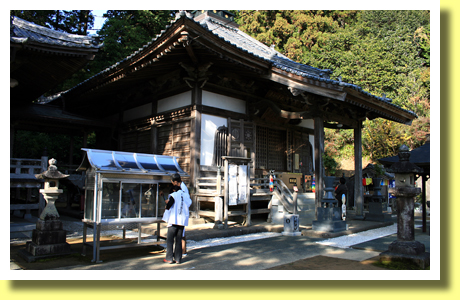
In Mima-cho, which is located in the north of Uwajima City, there are two of the 88 temples which constitute Shikoku Henro Pilgrimage. They are Ryukou-ji Temple and Butsumoku-ji Temple ( above ). So lots of pilgrims visit there.
|
|
Mori-ke Residence
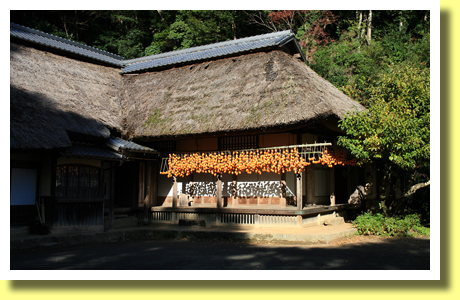
Also in Mima-cho remains Mori-ke Residence consisting of a few houses and a gate, which was built for Shoya ( village headman ) in A.D.1851. On the site of the residence, local people put up various events such as Hoshi-gaki ( hanging astringent persimmon - above ).
|
|
Jako-ten
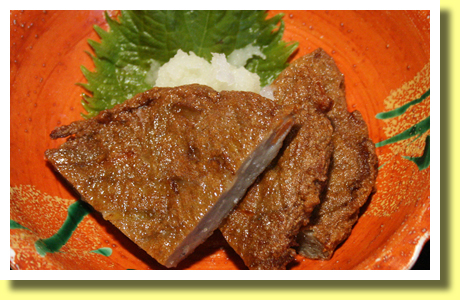
Jako-ten ( above ) is one of popular local specialty foods, served in many restaurants and izakaya in Uwajima. Also there are many shops selling Jako-ten in the city and its surrounding area. Jako-ten, broiled and served with grated daikon radish and soy sauce, is so nice with sake and/or beer. Also Jako-ten could be used in various dishes.
|
|
Making Jako-ten
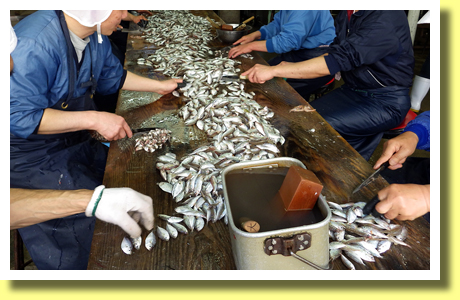
Tourists could see people making Jako-ten in some shops in Uwajima. Jako-ten is made usually from Hotarujako ( lanternbellies ) and some more small fishes. Fishes are 1) ground with seasoning after their viscera and heads are removed ( above ), 2) shaped and 3) deep-fried.
|
|
Tai-meshi

Tai-meshi ( above ) is the most popular one of local specialty dishes served in many restaurants and izakaya in Uwajima, where Tai-meshi is a bowl of "meshi" ( rice ) topped with slices of "Tai" ( sea bream or red snapper ) and sauce made from raw egg, shoyu ( soy sauce ) and broth. Sometimes seaweed and/or spring onion is added.
In Matsuyama, the capital city of Ehime Prefecture, Tai-meshi is popular as well. However Tai is boiled with rice in Matsuyama Tai-meshi, which is diiferent from Uwajima Tai-meshi.
|
|
Fuka-no-yuzarashi
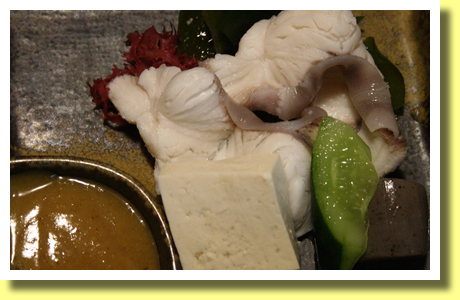
Fuka-no-yuzarashi ( above ) is another one of my favourite local specialty dishes. Slices of shark ( startspotted smooth shark ) are 1) soaked in salt water, 2) exposed in hot water and 3) soaked in cold water, then ready to eat with vinegared miso ( soybean paste ). Fuka-no-yuzarashi goes very well with sake. It is served in restaurants and izakaya in Uwajima and its surrounding areas.
|
Copyright (c) 2021 Achi-Kochi Zanmai Co., Ltd.
|